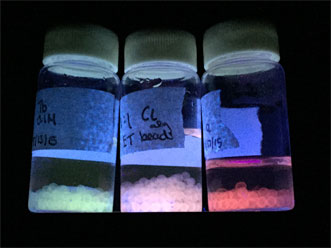Responsive to a range of stimuli, a color-changing metallic substance could help detect problems as varied as mechanical strain and pollution.
The material can be engineered to emit specific colors — even pure white — under different circumstances. In this way, the material could be used to detect chemical or biological compounds, as well as mechanical and thermal conditions.
"It's supersensitive to external parameters," said Niels Holten-Andersen, an assistant professor of materials science and engineering at the Massachusetts Institute of Technology. "Whatever you do will change the bond dynamics, which will change the color."

Luminescent materials are shown under UV light, emitting different colors that can be altered by environmental conditions. Courtesy of Tara Fadenrecht/MIT.
The material comprises a metal from the lanthanide group, also known as rare-earth elements, and a widely used polymer called polyethylene glycol, or PEG. Its light emission can be tailored to reflect very subtle changes in the environment, providing a color-coded output that reveals details of those conditions.
For example, the material could be engineered to detect specific pollutants, toxins or pathogens, with the results instantly visible through color emission.
The material can also detect mechanical changes and could be used to detect stresses in mechanical systems. The material can be made in a gel, thin film or coating that could be applied to structures, potentially indicating the development of a failure before it happens.
It could also help measure forces in fluids, Holten-Andersen said.
"What’s nice here is that the materials change color in response to such a wide and rich set of stimuli," said Stephen Craig, a professor of chemistry at Duke University who was not involved in this research. "The fact that the reference state can be made white is quite useful; it’s often easier to detect by eye that something has a faint shade of green, for example, than that it is one shade of green as opposed to another."
The research was published in the Journal of the American Chemical Society (doi: 10.1021/jacs.5b07394).